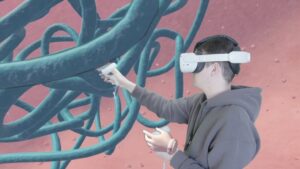

In the ever-evolving landscape of education, Virtual Reality (VR) has emerged as a powerful tool to transform how we approach STEM subjects. This article explores how VR education apps and VR education software can significantly enhance critical thinking and creativity in science, technology, engineering, and mathematics.
One of the key advantages of VR in STEM education is its ability to provide immersive, practical lessons. But what is a practical lesson in the context of VR? It’s an interactive, hands-on experience that allows students to engage with complex concepts in a three-dimensional space. This approach addresses a crucial question: What are some practical reasons for learners to participate in the lesson? The answer lies in the enhanced engagement, better retention, and deeper understanding that VR facilitates.
VR education companies like XReady Lab are pioneering the development of VR education games that simulate real-world scenarios. These simulations allow students to conduct virtual school experiments that might be too dangerous, expensive, or impractical in a traditional classroom setting. This safe environment encourages students to take risks, make mistakes, and learn from them – all crucial components of developing critical thinking skills.
When we consider how VR is used in education, one of the most exciting aspects is its potential to unleash creativity. In a virtual environment, students are no longer constrained by physical limitations. They can manipulate 3D models, create complex structures, and visualize abstract concepts in ways that were previously impossible.

For example, in a chemistry class, students can build and manipulate molecular structures in 3D space. In physics, they can visualize and interact with complex fields and forces. These experiences go beyond traditional science lesson plans, offering a level of interactivity and immersion that can spark creative thinking and innovative problem-solving.
How can VR be used in education to enhance critical thinking? By providing a platform for safe experimentation and immediate feedback. In a virtual lab, students can test hypotheses, analyze results, and draw conclusions in real-time. This iterative process is at the heart of scientific inquiry and critical thinking.

Consider a science experiment lesson plan on ecosystem dynamics. In a VR environment, students could manipulate variables like temperature, rainfall, or predator populations, and immediately see the effects on the ecosystem. This kind of rapid experimentation and feedback loop encourages students to think critically about cause and effect, to form and test hypotheses, and to draw evidence-based conclusions.
For secondary school experiment ideas, VR offers a wealth of possibilities. Imagine a biology class where students can shrink down to the cellular level and observe mitosis in real-time, or a physics class where they can manipulate gravity and observe its effects on various objects. These immersive experiences not only make learning more engaging but also help students develop a deeper, more intuitive understanding of complex concepts.
VR education services can also provide teachers with powerful tools for assessment and personalized learning. By tracking student interactions within the virtual environment, these systems can offer insights into each student’s learning process, helping teachers tailor their science lesson plans to individual needs.
While VR’s potential for artistic creativity is obvious – with applications like 3D modeling and volumetric drawing – its impact on creative thinking in STEM goes much further. By allowing students to visualize and manipulate abstract concepts, VR encourages them to think outside the box and approach problems from new angles.
For instance, in a mathematics class studying geometry, students could build and explore complex 3D shapes in ways that are impossible with traditional tools. This not only helps them understand the concepts better but also encourages them to think creatively about spatial relationships and geometric principles.
As we look to the future, it’s clear that VR will play an increasingly important role in STEM education. By combining the power of immersive experiences with rigorous academic content, VR education apps and games have the potential to revolutionize how we teach and learn science and mathematics.
The question is no longer what is science lesson or what is science lesson plan, but rather how can we use these powerful new tools to create more engaging, effective, and transformative learning experiences.
Virtual Reality offers unprecedented opportunities to enhance critical thinking and creativity in STEM education. By providing immersive, interactive experiences, VR allows students to engage with complex concepts in ways that were previously impossible. It encourages experimentation, fosters creativity, and develops critical thinking skills that are essential for success in the 21st century.
For educators interested in exploring the potential of VR in their STEM curriculum, XReady Lab offers free VR education apps for demo purposes. To experience firsthand how VR can transform your school lessons and ignite a love for learning in your students, visit https://xreadylab.com/request-demo-page/ and request a free demo of VR simulations. Even if you don’t have VR hardware, desktop versions are available to help you get started with this exciting new frontier in education.
As we continue to push the boundaries of what’s possible in education, VR stands out as a powerful tool for developing the critical thinkers and creative problem-solvers of tomorrow. By embracing these technologies, we can create a more engaging, effective, and inspiring STEM education for all students.
Frequently Asked
We prodive VR biology, VR physics, and VR chemistry simulations. Please, check our catalog.
Please, fill the form to get demo labs for free.
Please contact our customer support service at support@xreadylab.com or book a call with the team to find out the conditions and book the VR class set up at your school.
Subscription to XReady Lab interactive VR labs. If you are a school, then you are also given access to the VR classroom system. VR class system helps you easily launch VR lessons for a large number of students, follow the experience of each student, as well as customise the content without developers.
We adhere to the world’s generally accepted recommendations and research. Our products are suitable for children from 12 years old.